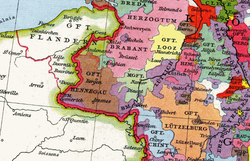County of Loon
| County of Loon | ||||||||||
|
Grafschaft Loon (de) Graafschap Loon (nl) Comté de Looz (fr) |
||||||||||
| State of the Holy Roman Empire | ||||||||||
|
||||||||||
|
The Low Countries around 1250, Loon (Looz) in yellow
|
||||||||||
| Capital |
Borgloon Hasselt |
|||||||||
| Languages | Limburgish | |||||||||
| Religion | Roman Catholicism | |||||||||
| Government | Principality | |||||||||
| Historical era | Middle Ages | |||||||||
| • | First mentioned | 1040 | ||||||||
| • | Gained Rieneck | 1106 | ||||||||
| • | Acquired Chiny | 1227 | ||||||||
| • | To Heinsberg | 1336 | ||||||||
| • | Annexed by Liège | 1366 | ||||||||
| • | Incorporated by France |
1795 | ||||||||
|
||||||||||
The County of Loon (Dutch: Graafschap Loon, French: Comté de Looz) was a province of the ancien regime Holy Roman Empire, lying west of the Meuse river in present-day Flemish-speaking Belgium, and east of the old Duchy of Brabant. The most important cities (bonnes villes) of the county were Beringen, Bilzen, Borgloon, Bree, Hamont, Hasselt, Herk-de-Stad, Maaseik, Peer and Stokkem. Its territory corresponded closely to that of the current Belgian province of Limburg. Like other areas which eventually came under the power of the Prince Bishop of Liège, Loon did not become formally linked with the rest of Belgium until the French revolution, but these events also brought the county to an end. Under various new names it first became part of France, and then of the United Kingdom of the Netherlands, before finally joining the new Kingdom of Belgium definitively in 1839.
...
Wikipedia


